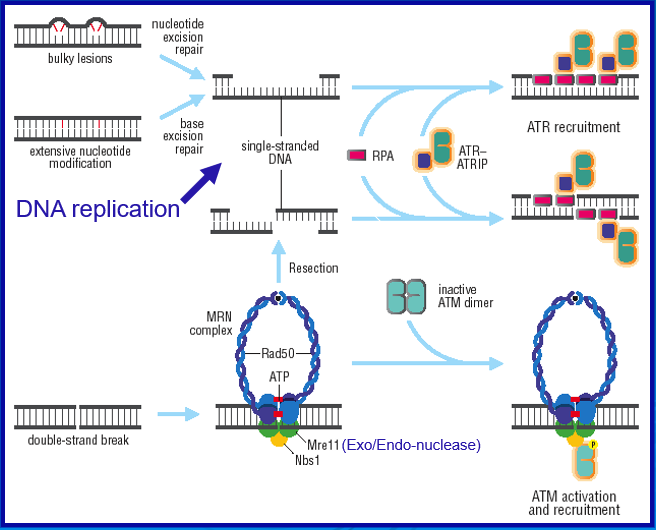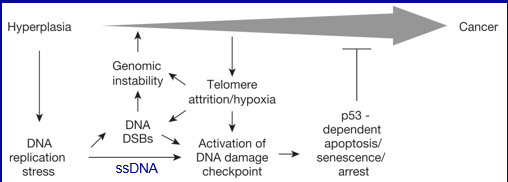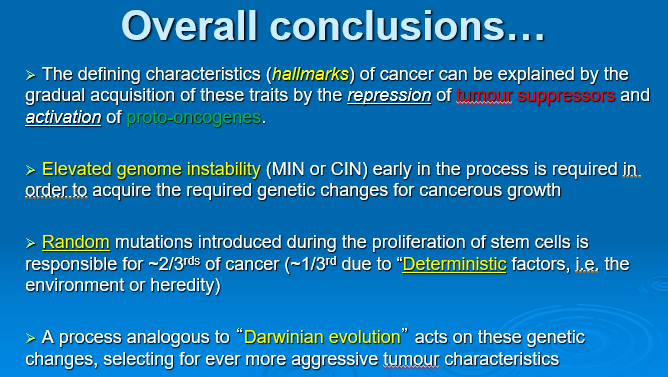DNA Damage Response
1/34
There's no tags or description
Looks like no tags are added yet.
Name | Mastery | Learn | Test | Matching | Spaced |
|---|
No study sessions yet.
35 Terms
What is the DNA Damage Response (DDR)?
The DDR is a network of biochemical signaling pathways that detect and respond to structural changes or damage in DNA, regulating cellular responses like repair, arrest, or death.
What types of DNA changes trigger the DDR?
Both DNA damage (e.g. double-strand breaks) and transient normal structures like single-stranded DNA (ssDNA) formed during replication.
What happens once DNA repair is complete?
The cell re-enters the cell cycle in a process called “recovery.”
What does an inefficient DDR cause?
Genome instability, where easily repairable lesions become mutations.
Why is DDR often called a “checkpoint response”?
Because it functions like a border control system, allowing cell cycle progression only if DNA integrity is verified.
Name five biological responses to DNA damage.
DNA repair
Apoptosis (cell death)
Senescence
Transcriptional regulation
Cell cycle arrest (G1, S, G2/M)
The recruitment & activation of protein kinases is critical to the DDR. Name 2 key types of protein kinases
PIK kinases (Phosphatidylinositol 3-kinase–like kinases): e.g. ATM and ATR
CHK kinases (Checkpoint kinases): e.g. CHK1 and CHK2
ATM and ATR are what type of kinase & are directed by what
They are protein kinases directed by serine/threonine
What gene is mutated in Ataxia Telangiectasia (Boder-Sedgwick or Louis-Bar sydrome)?
The ATM gene (Ataxia Telangiectasia Mutated).
Is Ataxia Telangiectasia a common/rare autosomal dominant/recessive disease
Is Ataxia Telangiectasia a rare autosomal recessive disease
Ataxia Telangiectasia is characterised by what
Progressive loss of Purkinje cells in the cerebellum which affects motor skills (ataxia - poor coordination)
Telangiectasia - prominent blood vessels in whites of eyes
Increased incidence of tumours (lymphomas/leukaemia)
Frequent immune problems
Poor appetite - very thin
When do symptoms of Ataxia Telangiectasia start to develop
Symptoms develop in toddler years
Ataxia Telangiectasia life expectancy & what does the person typically die from
Die by age 20
Bronchopulmonary infection / malignancy
In Ataxia telangiectasia, what suggests there is a defective response to DNA double strand breaks
Hypersensitivity to IR
What gene is mutated in Seckel syndrome (microcephalic primordial dwarfism / Harper’s syndrome / bird headed dwarfism)?
The ATR gene (ATM Related).
Is Seckel syndrome common/rare autosomal dominant/recessive disease involving an essential/non-essential gene
Rare autosomal recessive disorder involving the essential gene ATR
What is the significance of the ATR gene which is mutated in Seckel Syndrome being essential
The syndrome is therefore caused by hypomorphic, rather than null mutations
Onset for Seckel syndrome
Prenatal onset
Symptoms & physical appearance of people with Seckel syndrome
Proportionate dwarfism
Severe microcephaly with “bird-headed” appearance (protruding nose, large eyes, low ears, small chin)
Mental retardation

Name 2 PIK kinases involved in the DDR
ATM
ATR
How are the PIK kinases (ATM & ATR) activated
ATM activation - DNA double strand breaks and binding to the MRN complex
ATR activation - single stranded DNA (arise during replication stress / base excision repair)

Once activated, what do PIK kinases do?
Phosphorylate downstream proteins
How are the 2 CHK kinases (CHK1/CHK2) activated
ATM phosphorylates and activates CHK2
ATR phosphorylates and activates CHK1.
Once activated, CHK1 and CHK2 phosphorylate targets that halt the cell cycle.
What role do adaptor or mediator proteins play in CHK kinase activation
They amplify signals of ATM/ATR → increased phosphorylation of checkpoint kinases
Name some adaptors/mediators involved in DDR
53BP1, BRCA1, MDC1, Claspin.
What are the two waves of the G1 checkpoint response?
Immediate response: Rapid post-translational activation of checkpoint proteins
Delayed response: Requires de novo transcription, mRNA export, translation, and complex formation
What is the role of ATM in the rapid response of the G1 checkpoint
ATM senses DNA double-strand breaks → phosphorylates CHK2 → quickly halts the cell cycle to allow repair.
What is the role of ATM in the delayed response of the G1 checkpoint
ATM stabilises p53
Stabilised p53 accumulates and induces transcription of genes such as p21 → cell cycle arrest at G1
What did immunohistochemistry studies show about DDR in cancer
DDR activation occurs in early (pre-neoplastic/pre-invasive) stages of tumors such as lung, melanoma, bladder, breast, colon, and lung carcinomas.
Is DDR activated in normal proliferating or inflamed tissues
No, DDR is not appreciably activated in these tissues.
What was observed in experimentally induced hyperplasias?
DDR activation occurred even in the earliest hyperplastic or pre-cancerous lesions.
What happens in cultured cells expressing S-phase promoting oncogenes?
DDR is activated immediately, before p53 loss and before genomic instability develops.
Name 3 S-phase promoting oncogenes
E2F1
Cyclin E
CDC25A
What is hyperplasia & what does it lead to
Hyperplasia = aberrant stimulation of cell proliferation
Hyperplasia, telomere attrition & hypoxia lead to replication stress (ssDNA & DSBs) → activate DDR → Apoptosis (p53-dependent) & senescence → suppress expansion of precancerous lesion
BUT… subsequent mutations of the DDR results in loss of these crucial tumour suppressive mechanisms → further evolution of cancerous phenotype

